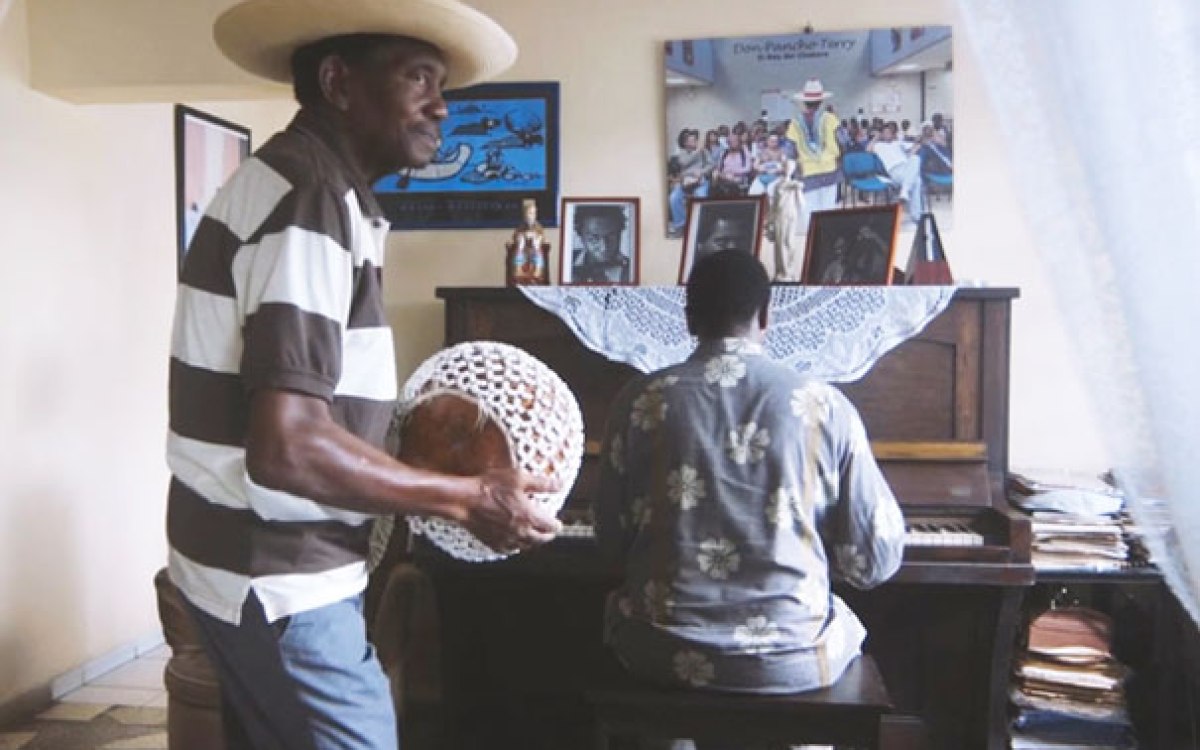Video: Ned Brown/Harvard Staff
A Cuba-Harvard connection, with a beat
Jazz band makes and learns music, absorbs culture on island visit
HAVANA — It isn’t easy to get to Güines. Though the town once contained Cuba’s leading sugar plantation slave enclave and its earliest railway, Güines (pronounced Gwin-es) isn’t listed on TripAdvisor or in any major travel guide. When the Harvard Jazz Bands traveled there recently as part of a musical tour of the island, security wouldn’t let their bus cross the small bridge into town, forcing it to find another route.
Once inside the town, though, the lessons from its rich musical past — and the visions of its hopes for the future — crystallized in a tiny courtyard covered in torn colored fabrics symbolizing the Cuban flag. The band members, under the guidance of Director Yosvany Terry, a native of Cuba, toured the historic one-room museum home of Tata Güines, one of the country’s top percussionists, and watched an Afro-Cuban performance of percussion, dance, and chanting by the National Folkloric Company of Cuba.
Listen: National Folkloric Company of Cuba
Appreciating Cuban music, its vast diversity, and how deeply it is sewn into the social and political fabric of the country was at the heart of the Harvard band’s trip. The fast-paced, eight-day musical adventure in early June marked the group’s first tour in 25 years, and Terry, a saxophonist and chekeré player who joined the faculty in 2015, organized an itinerary not only to showcase Cuba’s musical vibrancy, but also to illuminate recent efforts to rescue and preserve age-old traditions.
“This is the stuff that makes me tick. Coming from a percussion background, I’ve learned so much from watching them,” said Ethan Kripke, a sophomore who plays drums. “How they learn and internalize rhythm is just fundamentally different than in the United States. The clave is a fundamental rhythmic pulse that everything else — the percussion, the singing, the dancing — relates back to. It’s very precise but, if performed correctly, it gives the music a certain elasticity.”
“The clave is a fundamental rhythmic pulse that everything else — the percussion, the singing, the dancing — relates back to.”
Ethan Kripke
Listen: Clave
Music scholarship framed each day’s activities; the band members passed traditional Havana tourist sites such as Revolution Square and the Capitol Building with only a glance. Instead, Terry took students such as 19-year-old Jared Perlo, who plays trombone, to hear performances from the likes of Orquesta Típica Miguel Failde in Matanzas, the birthplaces of the music and dance traditions rumba and danzón, respectively.
“This was really a week of learning in an environment where these musical traditions were actually born,” said Perlo, the band’s tour manager, who organized the trip along with Terry. “Being able to learn in places with the masters is an experience that I don’t think anything else I will ever do in the jazz scene will ever compare to.”
The tour began in Matanzas, a fishing town on the northern shore that is home to some of the country’s biggest musical groups. On the way, the young musicians visited Castillo de San Severino, a military fortress built in 1735 and rebuilt years later as an entry point for slaves. Inside is the National Museum of the Slave Route, where students viewed the displays of African drums (Yuka, Bembé, Arará, Makuta) and mannequins representing various gods (Ogun, the Yoruba god of war and ironworkers; Ochossi, god of hunters and justice).
“It’s important to come here and see how these traditions have survived, and have been kept, and the different ways they have evolved and mixed with other cultures,” said Terry.
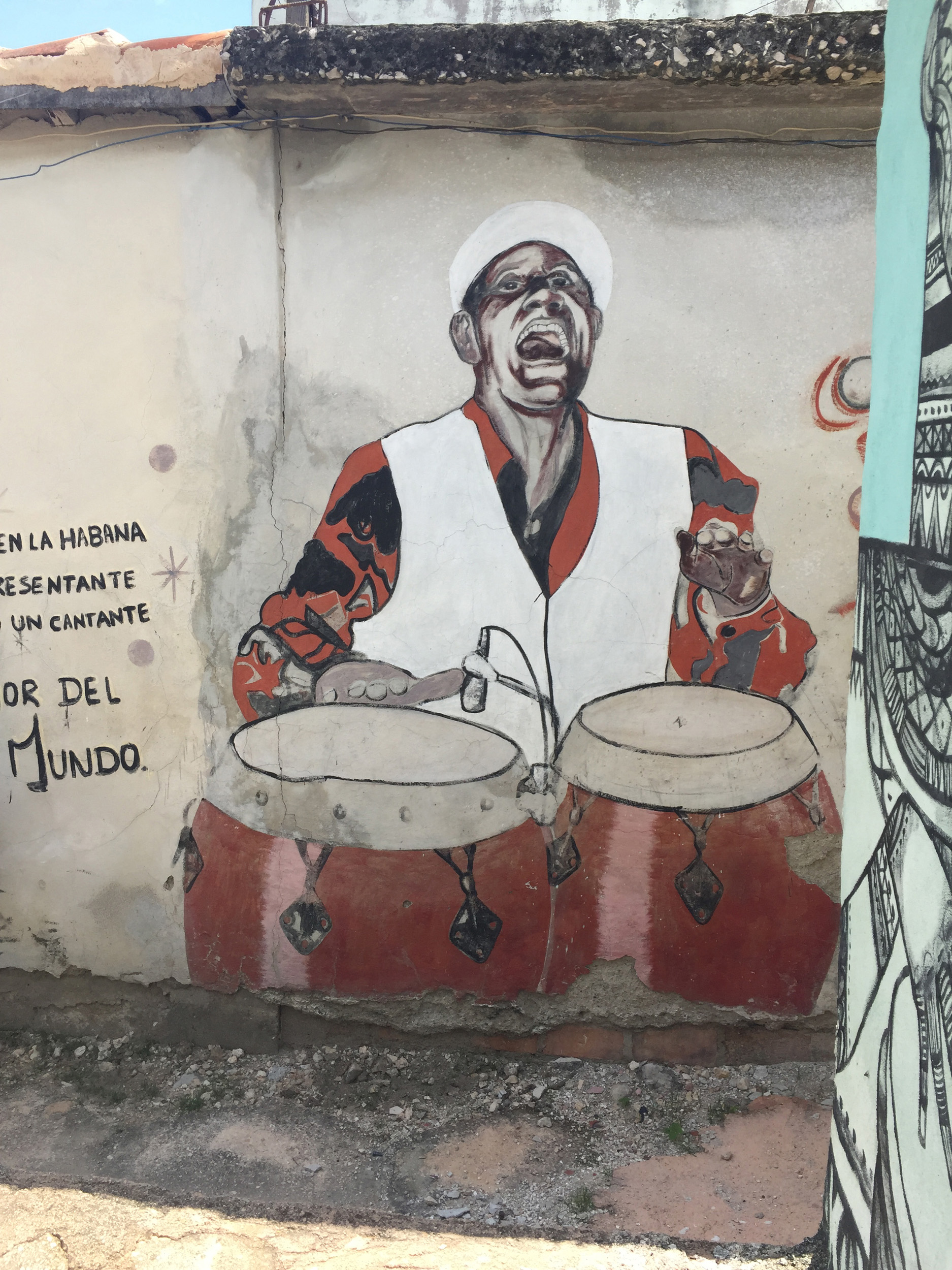
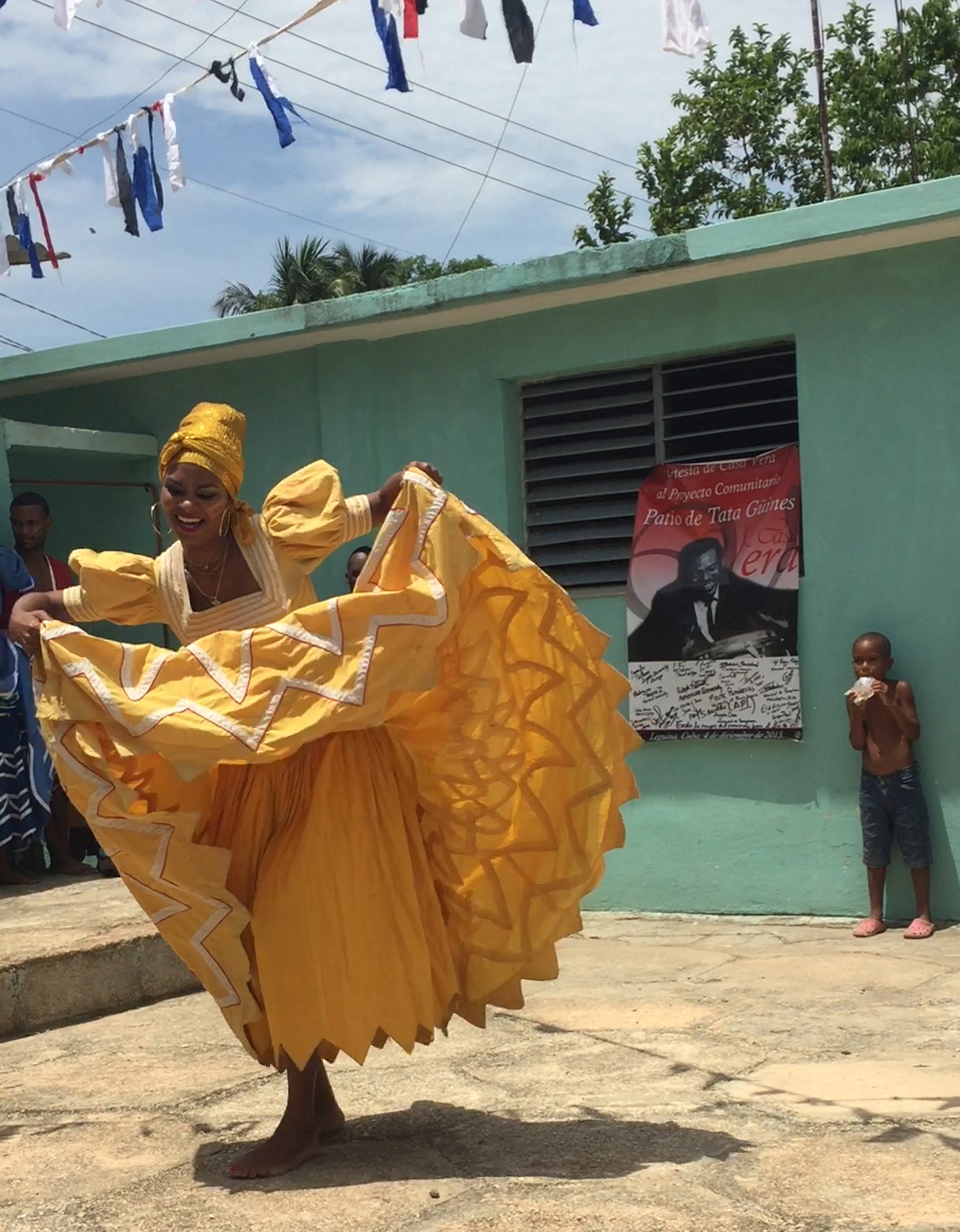
A member of the National Folkloric Company of Cuba dances in the Tata Güines museum courtyard where a mural pays homage to the drummer.
Photos by Jill Radsken/Harvard Staff
* * *
At the newly restored José White Concert Hall, the jazz band sat up front for a performance by Orquesta Típica Miguel Failde. Named for the bandleader who originated danzón in 1879, the dance combines European and African rhythms with elegant footwork. Failde’s great-great-grandson Ethiel, a flutist, led his band of musicians, ages 18 to 37, while an elderly couple — impeccably dressed, the woman holding a fan — strolled across the stage and began to move.
Orquesta Típica performed several dynamic pieces, including the popular “Almendra” and “Daulema,” which was composed by Terry and trumpeter Jesús Alemañy. Then Failde invited the students to join the musicians on stage. Junior Brian Rolincik, who plays trombone, was among the first to join the “adrenaline-filled moment.”
Listen: Orquesta Típica Miguel Failde
“It was cool to be so welcomed and to just feel deeply entrenched in this Cuban tradition of danzón. Music is such a universal language, both in terms of the notation and the feelings you get from it, and in the camaraderie it creates among people of diverse cultures,” said the 21-year-old, who is studying linguistics. “To start to not only learn on an intellectual level the difference between our and Cuban culture, but to feel in the daily routines here what human experience comes down to — how you interact, how you speak — all of those habits comprise the culture. To try to feel those and to try and emulate those is a lot I can take away.”
A couple performs a danzón, a Cuban dance combining European and African rhythms, with Orquesta Típica Miguel Failde in Matanzas.
Jill Radsken/Harvard Staff
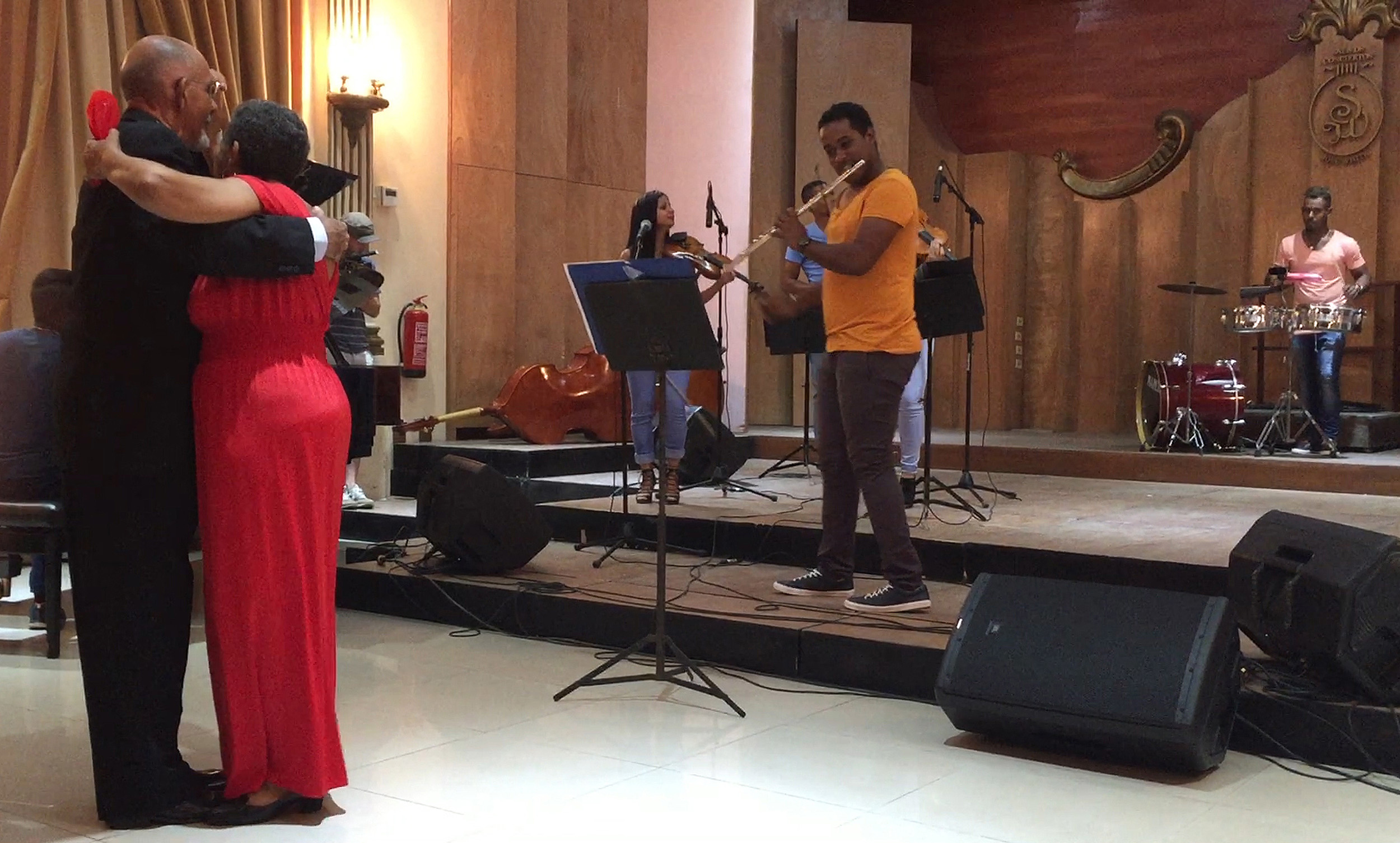
There was more to absorb at an afternoon performance by Los Muñequitos de Matanzas. Trading the wood-paneled concert hall for a modest, second-story room with a tin roof, the students sat on the red-painted cement floor to watch the legendary rumba group. Dancers honoring traditions brought to Cuba by African slaves spun around the room in red, blue, and gold costumes while multiple percussionists drummed.
“What’s so impressive is that the Cubans have internalized rhythms typical of Afro-Cuban jazz that don’t come as easily to us. Conversely, American students tend to feel comfortable in swing time. It’s striking to me that it’s [Yoruba] music that predates everything we study,” said guitarist Evan Vietorisz, whose Cuban grandmother immigrated to the United States in 1946. “She never shared anything with our family about her heritage because she sought to assimilate. It’s cool to be visiting Cuba and experiencing the culture that … hasn’t been part of my upbringing.”
Listen: Los Muñequitos de Matanzas
“To see a Muñequitos show is priceless,” said Terry, who grew up seeing the 65-year-old group perform. “The work that they’re doing is very important for the younger generation because it continues the oral tradition of passing information from the older generation to the younger. It’s the first time my students are experiencing a real rumba, expressed with authenticity. I can teach this in classes, but it’s different to see. It inspires my band to look back into their own culture and use that inspiration to move things forward.”
That kind of personal connection struck John Miller, a junior studying statistics, when he stepped off the tour bus the next day in Güines. The saxophone player, who grew up in Westlake, Calif., noticed among the crumbling buildings and stray animals in the town square children playing in a bright pink bouncy house and riding plastic toy cars.
“That scene is very familiar to me. It looks exactly like the parks near my grandparents’ house. My mom’s family is Mexican, and they live in Chino, a very Mexican part of California. Everyone gathers in the parks for celebrations and get-togethers,” he said.
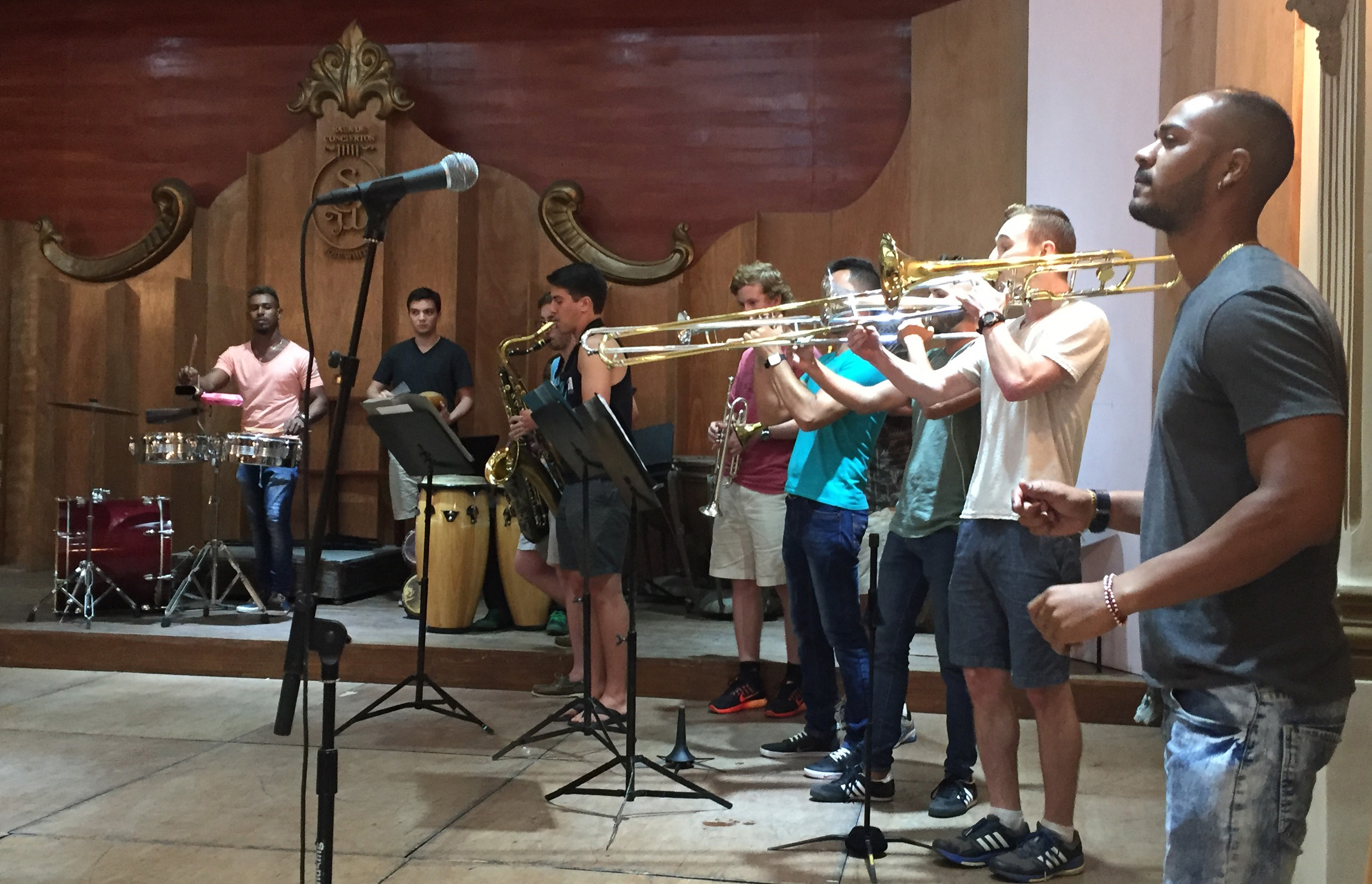
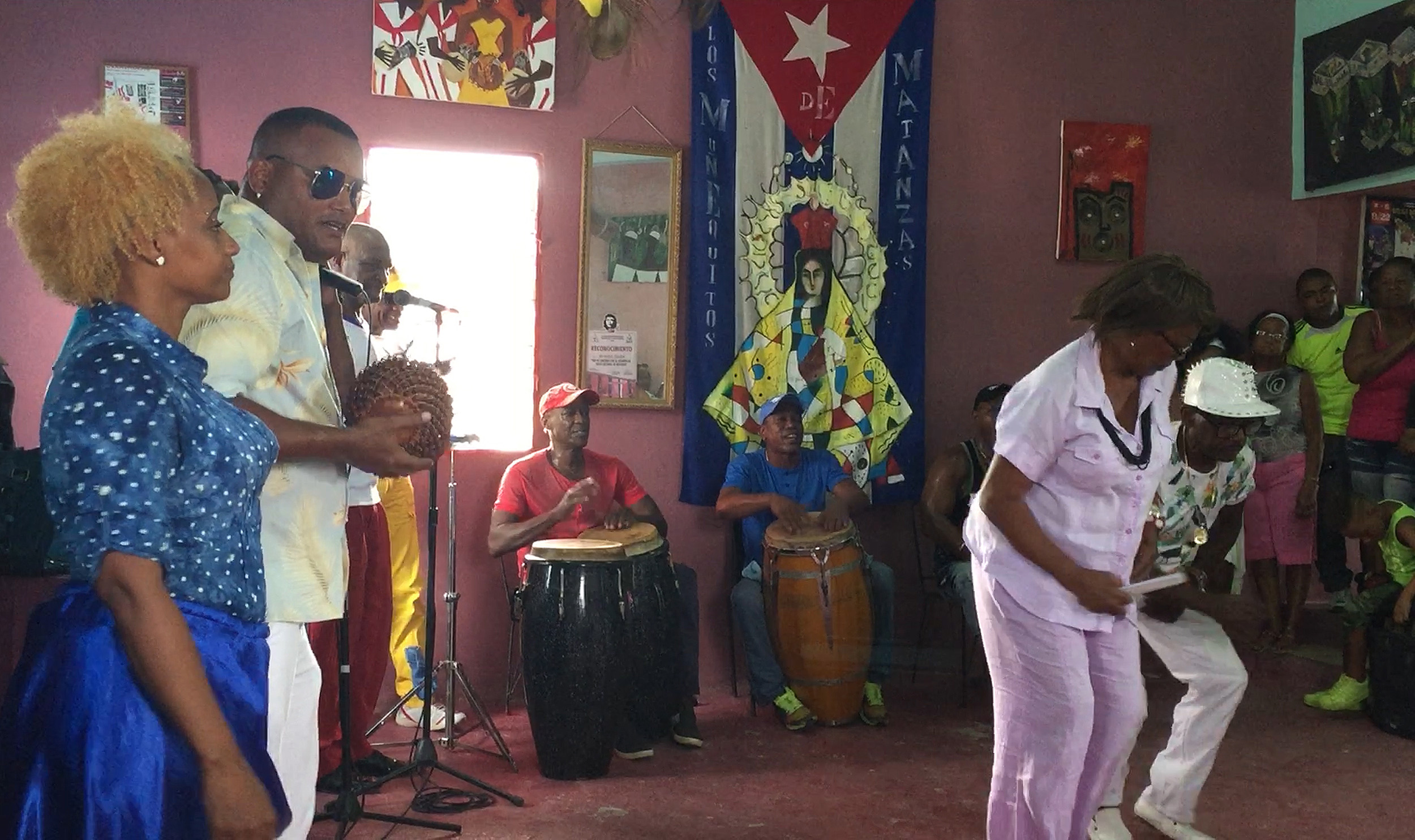
Harvard students take the stage with Orquesta Típica Miguel Failde in Matanzas. Los Muñequitos de Matanzas perform rumba, honoring African traditions through dance, chanting, and percussion.
Photos by Jill Radsken/Harvard Staff
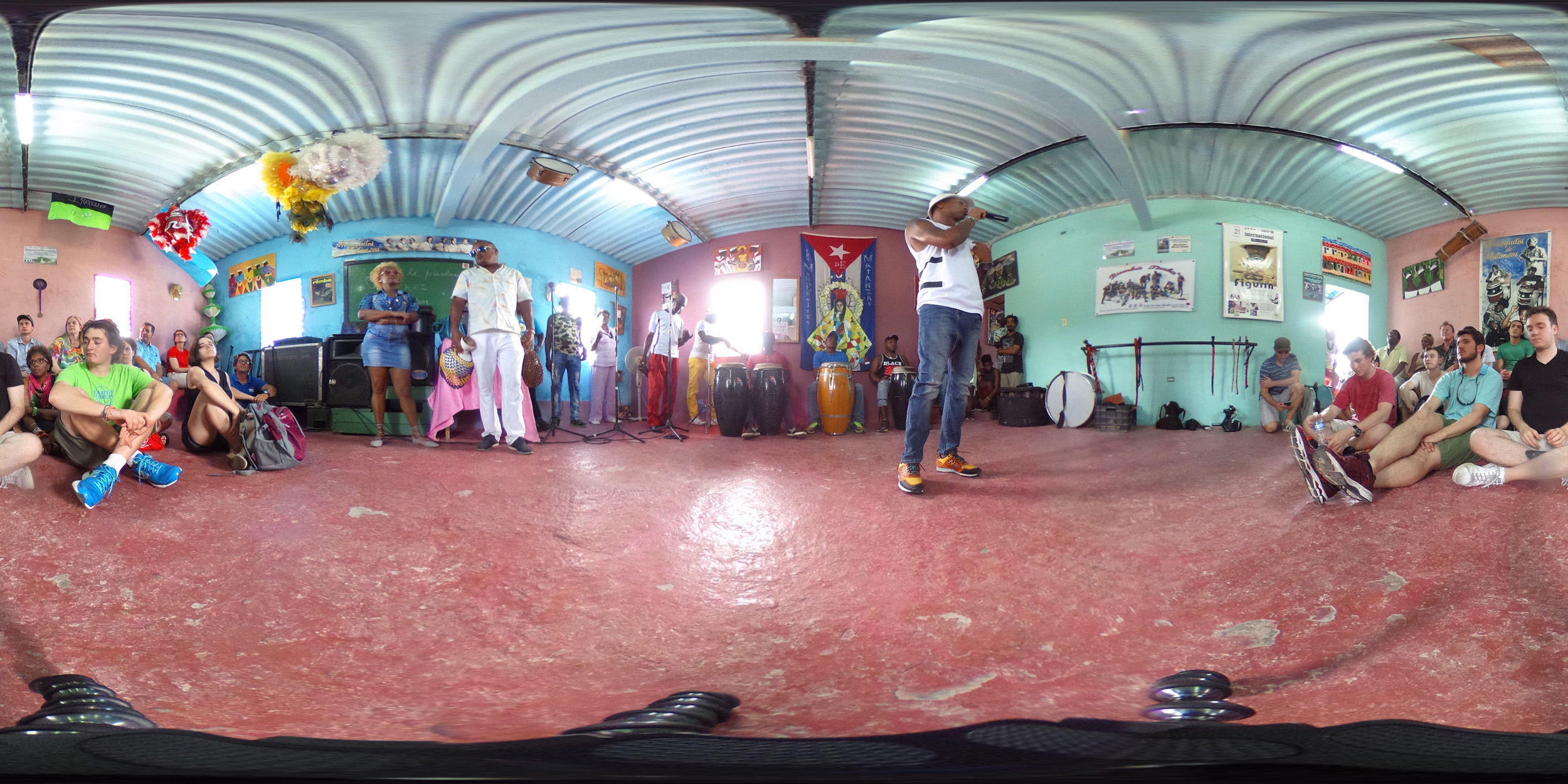
Ned Brown/Harvard Staff
* * *
In deciding to visit Güines, Terry said he wanted his students to see how a poor town used its musical roots to keep local children “out of trouble and get them into the community.”
“Tata Güines was an incredible force to reckon with, venerated around the world. This isn’t a modern museum, or a beautiful part of Cuba,” he said. “But here is where they’re using art to empower the kids.”
Visiting the museum where percussionist and composer Güines grew up, band members listened to the Cuban tour guide recount his modest roots. The son of a laundress, he banged out his first beats on the bottom of his mother’s wash bin. “They were very humble people,” she said, before leading the Harvard band into the courtyard for a performance. “The king of the drums was born.”
As local drummers hit the sacred bata drums, dancers colorfully dressed to represent their deities and orishas — minor gods — circled the courtyard. After the performance, several students were invited to learn the rhythmic patterns.
“Having the village elder come up and introduce it and demonstrate it, that was the definition of an educational moment.”
Jared Perlo
Listen: Bata drums
“Having the village elder come up and introduce it and demonstrate it, that was the definition of an educational moment,” said Perlo.
Perlo’s drive to make the trip happen was prompted, in part, by his father’s experience. Don Perlo ’83 played in the Harvard band during his time at the College, and toured with the group in the Dominican Republic 26 years ago.
“Ever since meeting Yosvany, I knew there was something special he brought to rehearsals and campus. We’d hang around after rehearsal, and he’d talk about how he was influenced by his upbringing in Cuba. Knowing his creative spirit and willingness to try new things, well, here we are,” said Perlo.
Home base during the tour was a hostel called Casa Vera in the Vedado neighborhood of Havana. The band was composed of 13 undergraduates and three other musicians, including newly graduated Sara Politz, who will teach ethnomusicology this fall at Williams College; Cuban trumpeter Yaure Muniz; and alumnus (and professional trumpeter) Bob Merrill. The week would culminate with an official concert by the band at Casa de las Américas in Havana, preceded by visits to several conservatories to work with local music students.
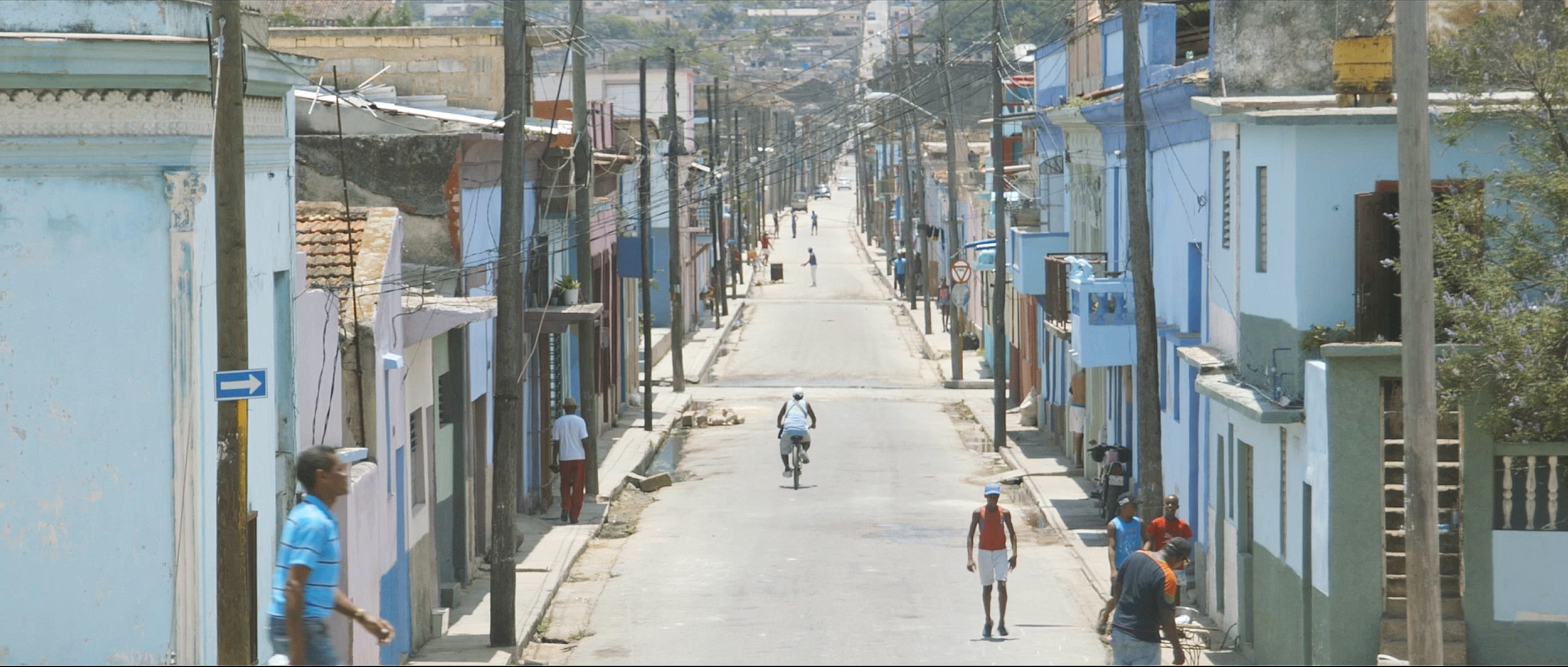
Ned Brown/Harvard Staff
* * *
On the bus rides to the schools, the Harvard students heard about Cuba’s history from tour guide Manny Calvo, who explained the importance of poet José Martí, a national hero, and passed around his own ration book, listing the quantities and types of food his family was eligible to receive every month. Cary Garcia Yero, a Ph.D. student at Harvard studying Cuba’s history, added context to the conversation about Fidel Castro’s revolution and the nation’s racial dynamics, and shared a Harvard connection: During a U.S. occupation of the island in 1900, 1,300 Cuban teachers trained in Cambridge before returning home.
“Seeing a country like Cuba is fascinating because my mom is from the former Soviet Union,” which was a communist state as Cuba is, said Jake Tilton, a junior tenor saxophonist who is concentrating in music and government. “Cuba is sort of a time capsule into the age that my mother lived in. It’s interesting to see the system she lived under, and how those political and social systems work.”
Music was never far from the conversation, and even small moments on the bus felt momentous for the students. On one ride, Terry queued up Herbie Hancock’s “Watermelon Man,” asking: “Everybody got a flute?” The band members hummed and tapped imaginary instruments in unison to the music coming from the speaker.
“That might have been the coolest five minutes I’ve spent on a bus,” said saxophonist Richard M. Feder, a junior from Long Island studying astrophysics.
Terry’s hopes for the trip were twofold: to expose the students to “one of the most sophisticated cultural bastions of the Americas” and to break the barrier between professor and student in a more experiential setting.
“I wanted them to experience the intellect and visual culture from the eyes of a Cuban citizen,” he said. “And it was intentional to take them out of what would be the obvious tourist instinct.”
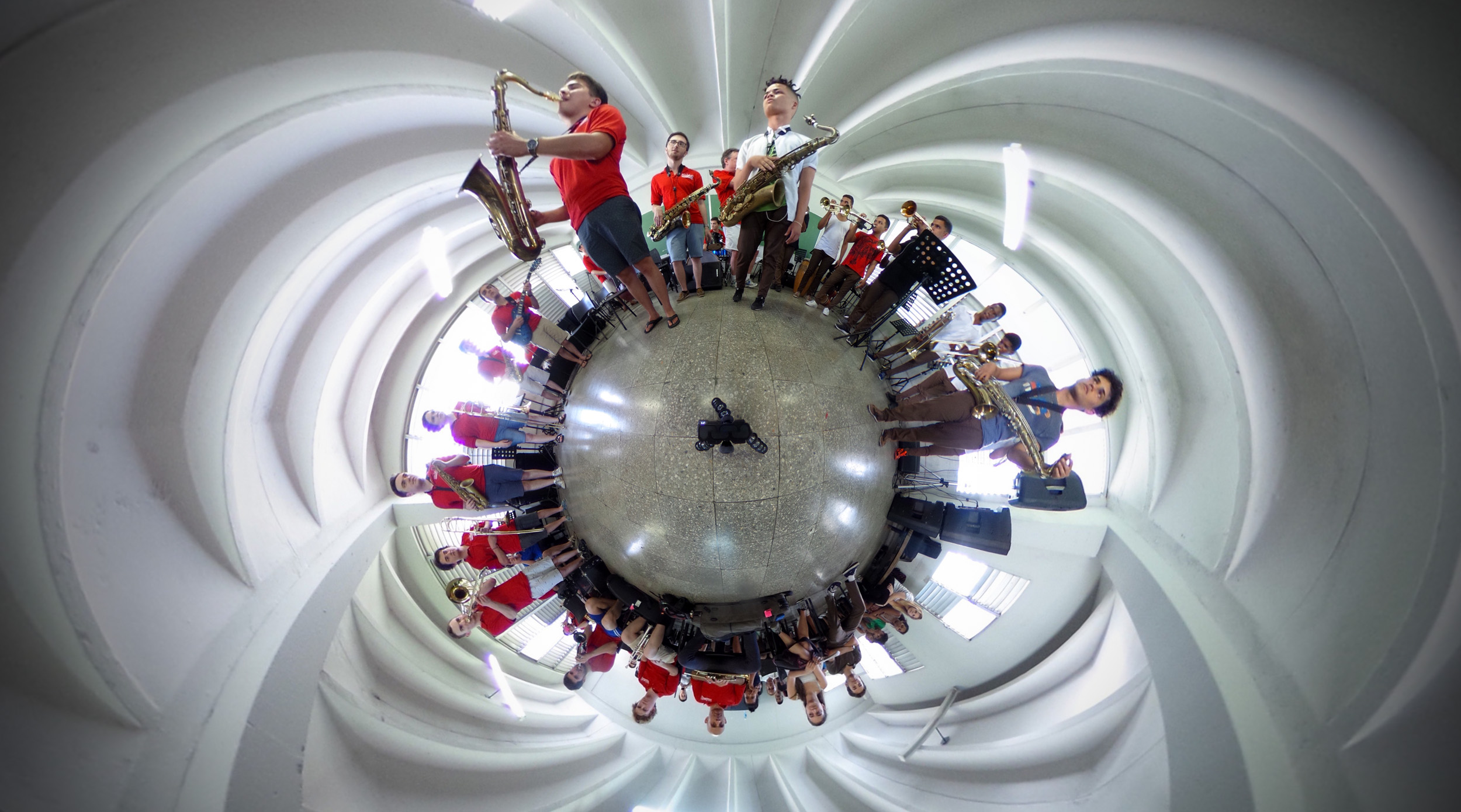
Ned Brown/Harvard Staff
* * *
Nowhere was the challenge to conventional American musical sensibilities felt more acutely than in visits to three conservatories: Guillermo Tomás, Amadeo Roldán, and the National Schools for the Arts (La Ena). At each, the Harvard band donated a musical instrument and music stands as part of the Horns to Havana program. At Amadeo Roldán in Centro Havana, piano student Rodrigo Garcia led his band in a performance, then listened to the Harvard group perform.
“Many Cubans have looked for the way to get into the world of American music that, to us, is also a very rich culture worth studying,” Garcia said. “All exchanges that we have with American musicians are a gift for us. And they are also a way for us to communicate, a way to unite cultures, a way to create a bridge between these two countries that are so close but that have been separated for so long for reasons that are not valid to us.”
It was at La Ena, where Terry studied in 1990, that the jazz band spent an afternoon workshopping with two bands. Conceived on a former country club golf course by Castro in 1961, the campus is made up of Catalan-vaulted buildings, which house schools of dance, dramatic arts, music, and plastic arts. On a walk around the sprawling campus, the band watched dancers rehearse, then visited a waterlogged ballet performance space. Built but never used after Alicia Alonso, one of Cuba’s prima ballerinas, refused to dance there, the terra cotta building sits in disrepair, with the only sound coming from bats flying inside the domed roof.
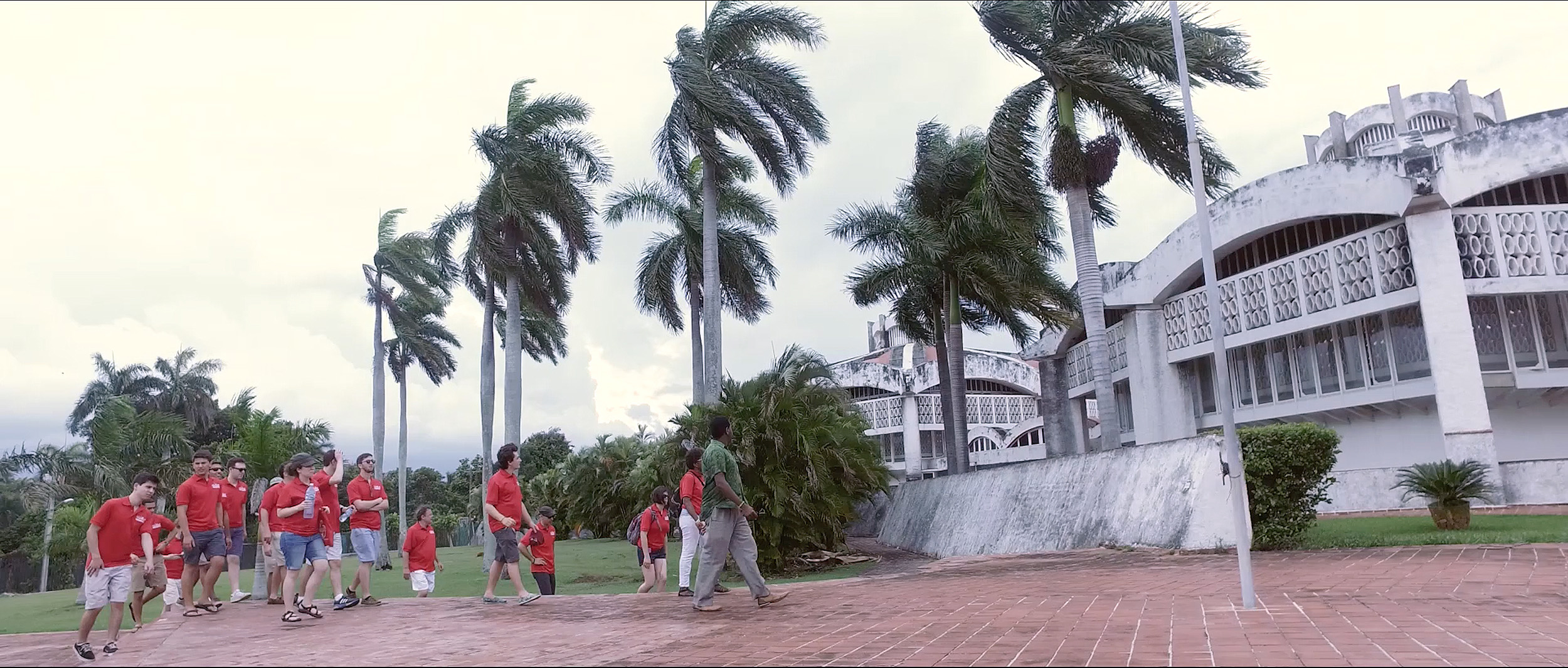
Yosvany Terry and members of the Harvard band visit Cuba’s National School for the Arts.
Ned Brown/Harvard Staff
“The Cuban music tradition uses polyrhythms, which American musicians are less familiar with. Several of the Cuban musicians we worked with tried to teach us polyrhythms, and it was very difficult at first.”
Diana Gerberich
Listen: Polyrhythms
In a music classroom, conservatory students played for the band, and listened as Harvard students took their turn playing at the front of the classroom. With Terry and Yero translating, the Cuban teens asked how Harvard students played so well even though most of them concentrate in other disciplines.
“Here your life revolves around your music,” said Yero, explaining that Cuban children begin their singular path to musicianship at ages 7 or 8.
Reflecting on the La Ena exchange, baritone saxophonist Diana Gerberich, who grew up in Wilbraham, Mass., and had never been abroad before, was fascinated by the difference between how the two cultures “learn and interpret their music.”
“The Cuban music tradition uses polyrhythms, which American musicians are less familiar with. Several of the Cuban musicians we worked with tried to teach us polyrhythms, and it was very difficult at first. The Cuban musicians seem so comfortable with it, though. It’s interesting to reflect on what we understand versus what other people understand,” she said.
* * *
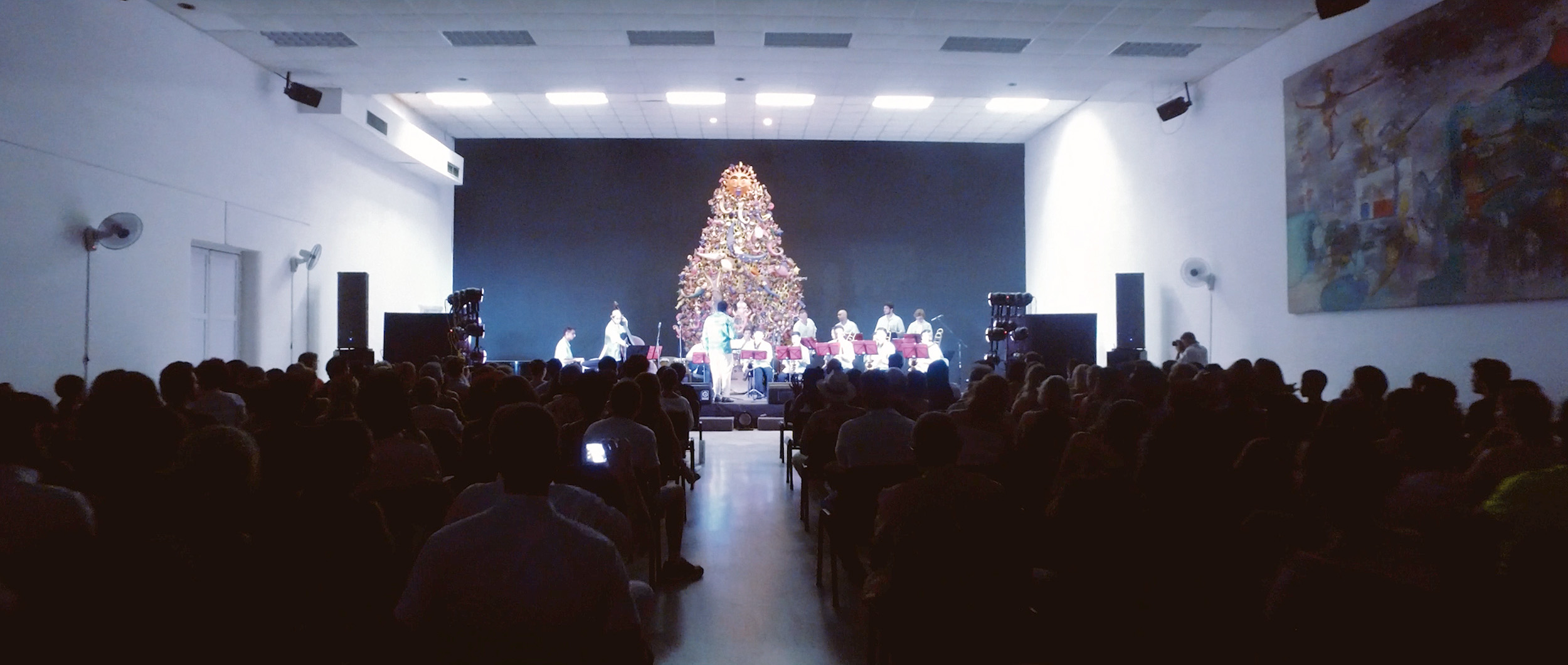
After a week of touring and workshops, the Harvard band showcases its new knowledge in a concert.
Ned Brown/Harvard Staff
After a week of engaging with students and performers, the jazz band took the stage at Casa de las Americas for a community concert. The Jam Session concert featured many of Terry’s friends, illustrious Cuban musicians including composer Bobby Carcassés, chekeré player (and Terry’s father) Don Pancho Terry, trumpeter Julito Padrón, and bass player Gastón Joya. Wearing light-blue guayaberas, the band performed a range of pieces to a full house for nearly two hours, including George Cables’ “Dark Side, Light Side” and “Moten Swing,” Cuban composer Joaquín Betancourt’s “Manteca,” and Carcassés’ piece “Blues Guaguancó.”
More like this
Kripke, the drummer, played alongside acclaimed percussionist Yaroldy Abreu, and was still star-struck afterward. “This past week I was constantly exposed to new rhythmic ideas, and different interpretations of the ones I knew. I was expecting this to be the case because of Cuba’s rich West African musical tradition. In the culminating concert, I tried to put all of my new knowledge to use. I incorporated ideas into my playing tonight that only a week ago I wouldn’t have considered. And Yaroldy looking over to me while letting out a joyous scream after I played some particularly Cuban-inspired fill was enough to know that I had succeeded.”
After the concert, the band shared a late-night dinner with the luminaries, and Perlo declaring the week “mind-blowing.”
“This will be my favorite memory of Harvard. On a music and jazz level, I’ve learned more in seven days than in a couple of years in a classroom,” he said.
“I haven’t done many things in my life that have ended in an incredibly beautiful experience shared by 20 other people who will remember it for decades to come. It sounds like an overstatement, but I don’t think it will be.”
Next week: A profile on music professor, jazz band director, and Cuban native Yosvany Terry and his journey home.


